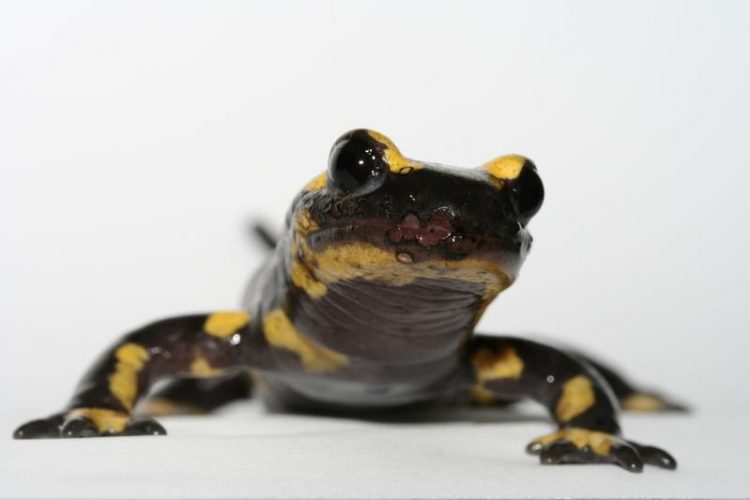European salamanders and newts vulnerable to fungal disease from Asia

A skin-eating fungal disease brought to Europe by humans poses a major threat to fire salamanders. Photo: Frank Pasmans
The previously unknown fungus Batrachochytrium salamandrivorans was discovered last year by researchers investigating a huge crash in the population of fire salamanders in the Netherlands.
Now the same team have screened over 5,000 amphibians from four continents to ascertain the threat the new disease presents to other species.The results, published today in the journal Science, show that B. salamandrivorans is very dangerous to salamanders and newts, but not to frogs, toads and snake-like amphibians called caecilians.
The fungus was found to be present in amphibians from Thailand, Vietnam and Japan as early as 1894, without causing disease, suggesting it originates from Southeast Asia.
The fungus probably arrived in Europe recently, and its presence in traded amphibians suggests that the intercontinental movement of amphibians explains its introduction. So far the disease has only been found in the Netherlands and Belgium, but the researchers say it is likely to reach other European countries soon. The great crested newt, a protected and threatened species in Switzerland, is among the species that rapidly die once infected.
No disease in the place of origin
The study was led by Professors An Martel and Frank Pasmans at Ghent University in collaboration with Dr. Ursina Tobler and Benedikt Schmidt at the University of Zurich and KARCH, the Swiss Amphibian and Reptile Conservation Programme, and others. “When a disease has been around for a long time, animals develop resistance to it.
Globalisation has resulted in the movement of humans and animals all across the world, bringing pathogens into contact with hosts that haven’t had the opportunity to establish resistance. As a consequence, pathogens like B. salamandrivorans that are brought to a new environment can very rapidly threaten many species with extinction,” said co-author Dr Benedikt Schmidt, from the Institute of Evolutionary Biology and Environmental Studies at the University of Zurich and KARCH, the Swiss Amphibian and Reptile Conservation Programme.
Biosecurity measures needed
Asian salamanders and newts are traded in large numbers across the globe. More than 2.3 million Chinese fire belly newts were imported into the US between 2001 and 2009. The researchers found that the fungus can easily be transmitted between salamanders of different species by direct contact.
Co-author Dr Benedikt Schmidt, from the Institute of Evolutionary Biology and Environmental Studies at the University of Zurich and KARCH, the Swiss Amphibian and Reptile Conservation Programme, said: “This study has shown the threat of importing exotic species without appropriate screening for infectious diseases. B. salamandrivorans poses an extreme risk to European amphibian biodiversity and nations need to urgently consider appropriate biosecurity measures to stop the further spread of this emerging pathogen”.
Literatur:
A. Martel, M. Blooi, C. Adriaensen, P. Van Rooij, W. Beukema, M.C. Fisher, R.A. Farrer, B.R. Schmidt, U. Tobler, K. Goka, K.R. Lips, C. Muletz, K. Zamudio, J. Bosch, S. Lötters, E. Wombwell, T.W.J. Garner, A.A. Cunningham, A. Spitzen-van der Sluijs, S. Salvidio, R. Ducatelle, K. Nishikawa, T.T. Nguyen, J.E. Kolby, I. Van Bocxlaer, F. Bossuyt, F. Pasmans: Recent introduction of a chytrid fungus endangers Western Palaearctic salamanders, in: Science. doi:10.1126/science.1258268
Funding of the study
The study was funded (among others) by the Special Research Fund of Ghent University, the Royal Zoological Society of Antwerp, Dutch Ministry of Economic Affairs. Funding in Switzerland came from Vontobel Stiftung, Janggen-Pöhn Stiftung, Basler Stiftung für biologische Forschung, Stiftung Dr. Joachim De Giacomi, Zoo Zürich, Grün Stadt Zürich, European Union of Aquarium Curators, and Zürcher Tierschutz.
Contact:
Dr Benedikt Schmidt
Institute of Evolutionary Biology and Environmental Studies
University of Zurich
Tel. +41 (32) 725 72 07, 078 719 69 16
E-Mail: benedikt.schmidt@ieu.uzh.ch
Bettina Jakob
Media Relations
University of Zurich
Tel. +41 44 634 44 39
E-Mail: bettina.jakob@kommunikation.uzh.ch
Weitere Informationen:
Media Contact
All latest news from the category: Ecology, The Environment and Conservation
This complex theme deals primarily with interactions between organisms and the environmental factors that impact them, but to a greater extent between individual inanimate environmental factors.
innovations-report offers informative reports and articles on topics such as climate protection, landscape conservation, ecological systems, wildlife and nature parks and ecosystem efficiency and balance.
Newest articles

Silicon Carbide Innovation Alliance to drive industrial-scale semiconductor work
Known for its ability to withstand extreme environments and high voltages, silicon carbide (SiC) is a semiconducting material made up of silicon and carbon atoms arranged into crystals that is…

New SPECT/CT technique shows impressive biomarker identification
…offers increased access for prostate cancer patients. A novel SPECT/CT acquisition method can accurately detect radiopharmaceutical biodistribution in a convenient manner for prostate cancer patients, opening the door for more…

How 3D printers can give robots a soft touch
Soft skin coverings and touch sensors have emerged as a promising feature for robots that are both safer and more intuitive for human interaction, but they are expensive and difficult…





















